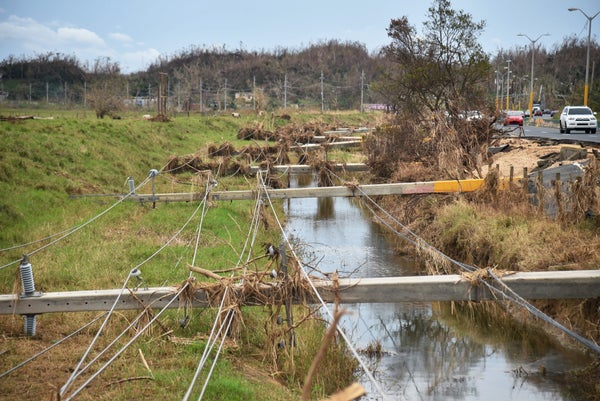It has been 68 days since Hurricane Irma took down much of Puerto Rico’s aging power grid and 54 days since Hurricane Maria finished the job, leaving nearly all 3.4 million residents without electricity. The island’s state-owned utility company, the U.S. government and workers on loan from other utilities are installing new poles, lines and power distribution circuits to replace those blown away by the storms. Despite the progress that has been made, more than half of Puerto Rico continues to soldier on without some of modern life’s bare necessities—including lights, refrigeration, air-conditioning and access to computer networks. Without significant improvements to create a more resilient grid, however, many are questioning how Puerto Rico can avoid a similar catastrophe the next time a major storm hits.
The consensus among the U.S. Federal Emergency Management Agency (FEMA), the U.S. Army Corps of Engineers and others involved in the current restoration project is that Puerto Rico is—and has been for a long time—in desperate need of a power grid makeover. Last Wednesday, during a press conference, Ricardo Ramos, executive director of the Puerto Rico Electric Power Authority (PREPA), indicated the utility has created a “transformation plan” to improve service. Within 24 hours of the press conference a transmission line supposedly repaired a few days earlier failed, plunging San Juan and several other cities back into darkness until power could once again be restored in the following days.
Such is the nature of power in Puerto Rico, as PREPA struggles to keep its fragile electrical grid online while promising to make improvements that to date have failed to materialize. A three-day blackout in September 2016 derailed the power utility’s previous push to upgrade the island’s fragile grid. (pdf, in Spanish) Ramos’s new plan lacks specifics but includes two key components: better distribution of power plants throughout the island and the implementation of microgrids that serve fewer customers but can keep the lights on when the main grid fails.
On supporting science journalism
If you're enjoying this article, consider supporting our award-winning journalism by subscribing. By purchasing a subscription you are helping to ensure the future of impactful stories about the discoveries and ideas shaping our world today.
Planning for Failure
A microgrid is a local, self-sufficient network of generators, storage devices (typically batteries) and equipment that routes electricity to homes, businesses and other structures that require service. A key benefit of such a setup is that it can operate as part of the main grid or function autonomously. These grids can be powered by diesel-burning generators or a combination of fossil fuels and renewable energy sources such as solar and/or wind.
Distributing the load in this way can alleviate reliance on one main system whose failure could cut power to the entire island. Puerto Rico needs a mix of microgrids disbursed throughout the island to provide electricity in a cost-effective way, says José Antonio Santiváñez, a professor of industrial management engineering at Puerto Rico’s University of Turabo. “Another reason microgrids are a good option for Puerto Rico is that there are hard-to-reach places on the island where [PREPA] said it would never be able to deliver power.” Those residents live off the main grid and already rely mostly on portable generators for electricity.
Many businesses and tourist resorts in Puerto Rico also have their own self-contained power networks in order to operate during emergencies or even PREPA’s normal power outages. PREPA’s customer outage rate is four to five times higher than other U.S. utilities (pdf). “The main problem, though, is that people living in rural areas don’t have the money to build or manage their own microgrids,” so the government would have to step in to help, Santiváñez says.
There are other drawbacks to these self-contained systems: “A lot of people want to be part of the main grid because the quality of the power is much better,” says Mike Hyland, senior vice president of engineering services for the American Public Power Association, a trade group for the utility industry. “That’s a big issue when it comes to electronics and manufacturing businesses, in which they can’t have transient spikes or blips causing sudden changes in voltage that could [damage] or freeze up their electronics.” The main grid’s large-scale energy production enables it to smooth over sudden changes in voltage in ways that a microgrid cannot. “I’m a big fan of microgrids, but they aren’t the saviors that many people think they are,” he adds.
The PREPA plan’s mention of distributed generation is an acknowledgement the island needs more generators positioned throughout the island, and that they need to be closer to their consumers. Many of PREPA’s largest power plants are in Salinas, Guayanilla and other towns near the island’s southern coast, where land is less expensive and the Commonwealth Oil Refining Co. once operated a large (now defunct) oil refinery. Most of the population, however, lives in the northern half of the island separated from the south by a mountainous central region.
It has been decades since the south was home to large facilities that needed lots of power, and “Puerto Rico’s governor has an interest in locating the power generators closer to the population that they support,” Maj. Gen. Donald Jackson, deputy commanding general for the Army Corps’ Civil and Emergency Operations, testified at an October 31 U.S. Senate Committee on Homeland Security and Governmental Affairs hearing. “That would obviate the long transmission lines currently needed across the island. The [U.S. Department of Energy] is looking at that.”
Such a move is long overdue, according to Santiváñez. “Bringing power from the southern part of the island to the northern part has been a lost cause,” he says. It has been more than two months since the storms and “most people still don’t have electricity.”
In addition to better distribution of power plants throughout the island, increased use of underground cabling could enable the power company to deliver electricity to customers without worrying about poles and lines downed by hurricane gales. That approach has been effective in areas of Puerto Rico’s capital, San Juan—although the cables could be vulnerable to damage from flooding. The limitations on underground cable include high costs—10 times greater than aboveground lines and poles—and the island’s mountainous terrain. Underground power cables also require more time and money to manufacture than do overhead wires, Hyland says. And, because they are out of sight, it is difficult to know when they have been damaged, he adds. Still, Hyland acknowledges it makes sense to consider subterranean lines in specific parts of the island for the future.
Another approach would be to supplement more of the grid’s diesel oil generators with power from solar and wind farms, although such power sources are too intermittent to replace a fossil fuel grid, Santiváñez says. Renewable energy sources such as solar panels would be good for one house or a group of homes—if they could afford it—but not for the entire island, he adds. “I have a suspicion that those solar panels in particular would be gone with the wind in the event of another category 5 storm,” he says.

Solar panel debris is seen scattered in a solar panel field in the aftermath of Hurricane Maria in Humacao, Puerto Rico on October 2, 2017. Credit: Ricardo Arduengo Getty Images
Red Tape
None of those upgrades will happen anytime soon, however, because FEMA is not allowed to fund them. The 1988 Stafford Disaster Relief and Emergency Assistance Act authorizes government agencies only to restore utility service to its predisaster condition. Additionally, PREPA has no money to pay for upgrades. “The U.S. Army Corps is working to reestablish the grid to U.S. code standards,” FEMA Administrator Brock Long testified at the October 31 Senate committee hearing. “Typically, we have to restore to a predisaster condition, but obviously that is not optimal and not the way I would ever recommend [Puerto Rico] to go. We do not want to be back in this situation again.”
A category 4 or 5 storm such as Irma or Maria will knock down any aboveground wires, Long added, even if they are attached to newly installed poles. “The discussion that needs to be taken after that is: How do we build a power grid that is resilient?” Long told the committee. “That’s going to require authorities far greater than the Stafford Act affords me and FEMA.” The agency needs additional legal authority from Congress for money to make any additional improvements, according to Long.
PREPA’s bankruptcy in May further complicates Puerto Rico’s efforts to improve grid resilience. The government-owned power authority is responsible for about $9 billion of the island’s $73-billion debt. Puerto Rico formed PREPA in 1941 to be the sole provider of electricity for the island’s then 1.5 million customers. The company’s power plants are, on average, currently more than 40 years old, Long testified, adding, “worldwide, the average age of power plants is 18 years.”
PREPA made headlines recently for awarding a couple of large contracts that would have spent a lot of FEMA’s money, apparently without the agency’s approval. The first was a $300-million deal with a two-person operation based in Montana called Whitefish Energy that has since been cancelled and is under investigation. Just a few days later PREPA awarded a second questionable contract to pay Cobra Acquisitions, a subsidiary of Oklahoma City–based Mammoth Energy, $200 million even though the small firm has little experience with disaster recovery. The power utility has since turned to utilities in New York State and Florida, whose services FEMA will help pay for. Public and private utilities in New York have already pledged to send 350 utility personnel and 220 vehicles, with more to follow.
Ultimately, major improvements to Puerto Rico’s grid will have to wait until after PREPA and its partners fix the hurricane damage to the existing infrastructure. “Trying to make big changes and get the power up and running at the same time are not necessarily in the cards,” says Steve Hauser, chief executive officer of the GridWise Alliance, a lobbyist organization pushing the U.S. government to invest in upgrades to the country’s power grid. Hauser, a former vice president of grid integration at the Energy Department's National Renewable Energy Laboratory adds, “If you want to rebuild it in a modern design, that probably takes years, not weeks.”
Not surprisingly, the restrictions on FEMA funding do not sit well with Puerto Ricans, many of whom face the daunting choice of living through at least several more weeks without power or evacuating to the mainland. PREPA plans to have 50 percent of its grid online by mid-November and nearly all of it up and running by mid-December. Other estimates, however, suggest some of the island’s rural areas likely will not be able to turn on the lights before springtime at the earliest.
